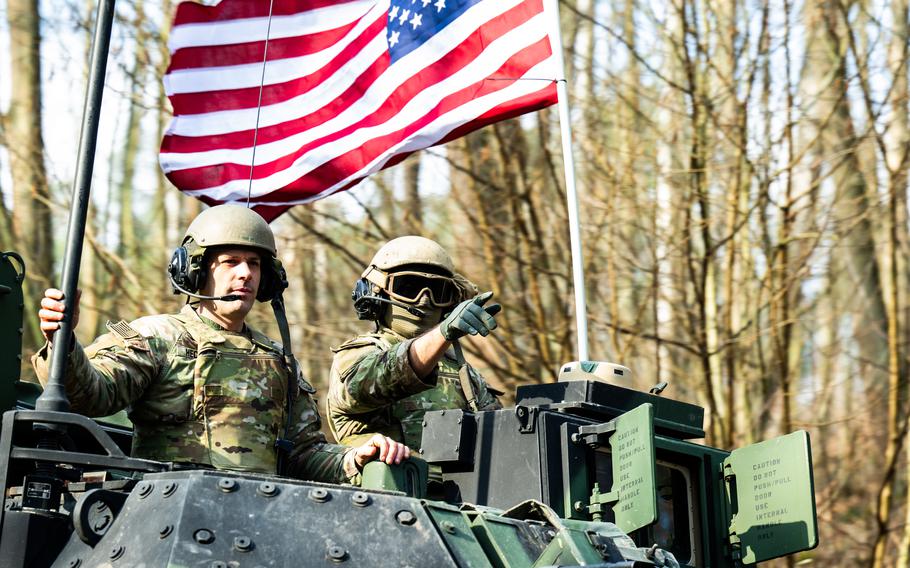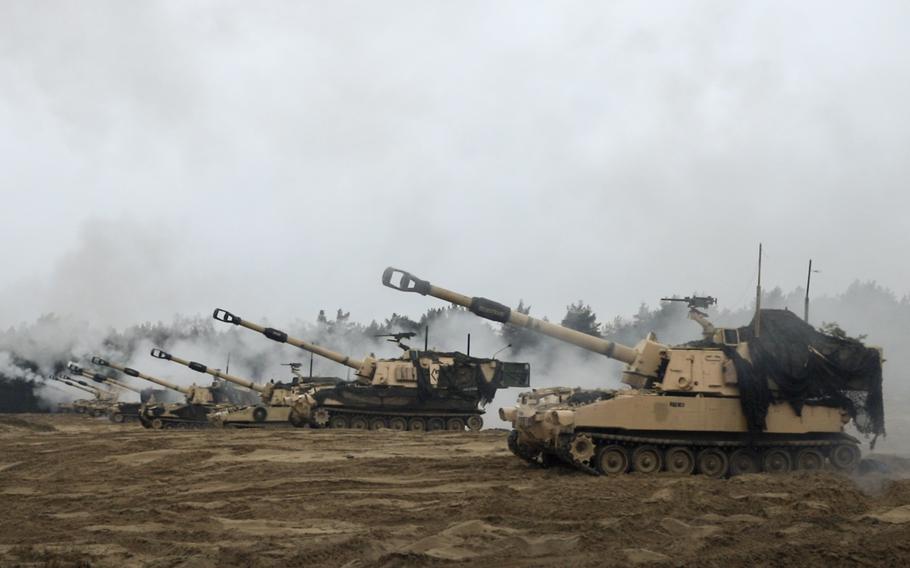
Soldiers conduct a movement with armored vehicles and tanks March 5, 2024, near the Vistula River in Poland during Exercise Dragon 24. The Center for Strategic and International Studies, in a report released Monday, said the U.S. Army should permanently station a brigade in Poland and maintain a similar rotational force in Romania to bolster NATO's defenses. (Jackie Faye Burton/U.S. European Command)
The U.S. Army should permanently station a brigade in Poland and maintain a similarly sized rotational force in Romania, according to new research that argues those steps could help some military families strained by years of long overseas deployments.
The Center for Strategic and International Studies said the threat posed by Russia merits a stronger commitment in Poland, where a more permanent force would stiffen deterrence on NATO’s eastern flank.
“Poland would provide the most practical and beneficial location to establish a new military base for an (armored brigade combat team) from an operational and political perspective,” said the report, which was released this week.
It also recommended that the U.S. station two combat aviation units in Poland. Such a move would essentially transition the Army’s rotational force in Poland into a permanent one.
The changes would save money over the long run, given that it’s cheaper to forward-base troops rather than shuttle large units and their equipment back and forth across the Atlantic Ocean every nine months, the report authors said.
The debate over how to best carry out the military mission in Europe has long centered on the balance between sending troops to the Continent on short-term missions versus offering tours with family in tow.
According to the report, there is evidence that accompanied tours translate into higher morale for soldiers when considering the family separations that come with long rotations away from home.
“Rotational deployments also lead to more discipline issues and increased divorce rates,” according to the authors, who also cited lower reenlistment rates for units involved in rotational missions.

U.S. Army M109 Paladins take part in a training mission in Torun, Poland, Feb. 22, 2024. A Center for Strategic and International Studies report released Monday recommends the permanent presence of an American armored brigade in Poland to bolster NATO's eastern flank. (Spc. Trevares Johnson)
Establishing a new U.S. base in Poland would have high initial costs and take roughly seven years, but “the financial burden of permanently stationed forces would be lower in the long run,” the report said.
However, it didn’t advocate moving away entirely from the rotational model. For example, rotating an infantry brigade through Romania would maintain flexibility and should be an enduring feature of the Army’s force posture, it said.
The service began sending infantry brigades to Romania in the aftermath of Russia’s 2022 full-scale invasion of Ukraine.
The analysis builds on other studies in recent years, including one by the U.S. Army War College in 2017 that found rotating armored brigades to Europe was more costly than forward basing.
Other data point to the possibility that the rotational model the Army has relied on in Europe is taking a toll on soldier well-being.
On Monday, Army Times reported that between 2019 and 2021, armored units, which are often involved in frequent overseas rotations, experienced a suicide rate twice as high as that of the rest of the active-duty force.
Since the 2014 invasion of Ukraine by Russia, numerous security analysts have argued in favor of assigning more troops to Europe, such as an armored brigade in Poland.
Army leaders, however, have not publicly signaled much interest, if any, in going in that direction.
With the threat posed by China in the Pacific, there could be pressure on the Army and other services to remain flexible and not overcommit itself in Europe.
China hawks have argued that Europe, given its wealth relative to Russia, should be able to make the military investments needed to carry a larger share of the conventional security burden on the Continent, especially given global demand on the U.S. military.
Other domestic constraints that could affect U.S. force posture in Europe in the years to come include the size of future defense budgets or “an isolationist turn in U.S. politics,” the CSIS report said.